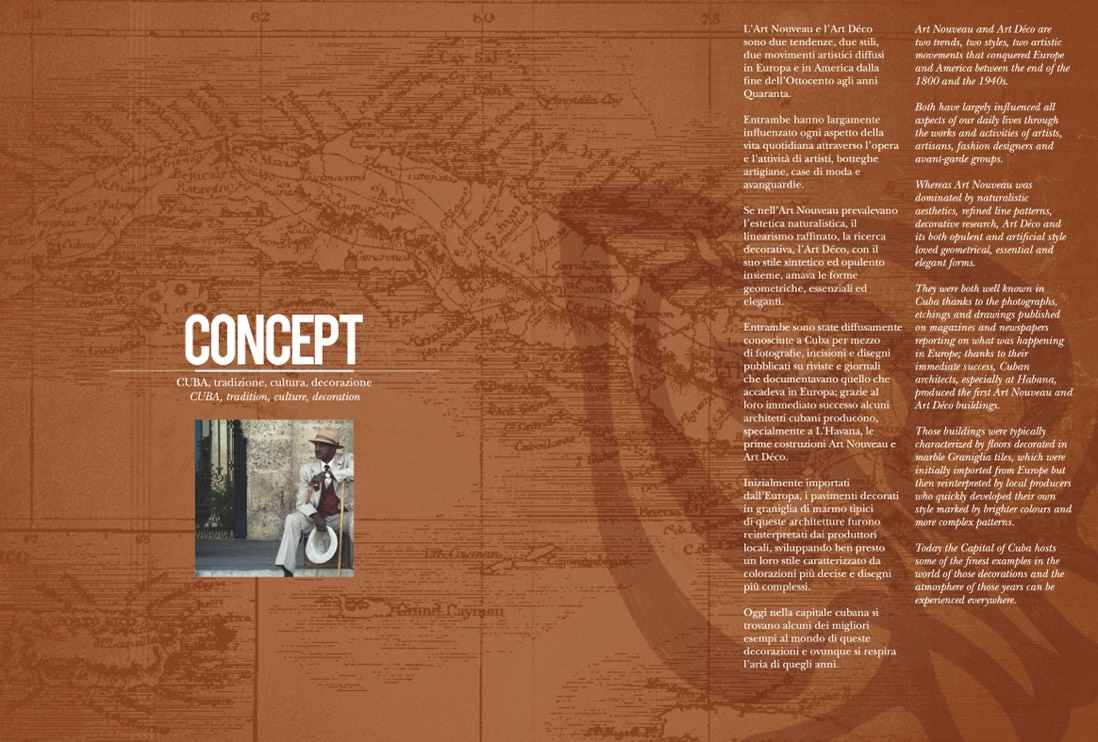
CONCEPT
CUBA, tradizione, cultura, decorazione
CUBA, tradition, culture, decoration
L’Art Nouveau e l’Art Déco
sono due tendenze, due stili,
due movimenti artistici diffusi
in Europa e in America dalla
fine dell’Ottocento agli anni
Quaranta.
Entrambe hanno largamente
influenzato ogni aspetto della
vita quotidiana attraverso l’opera
e l’attività di artisti, botteghe
artigiane, case di moda e
avanguardie.
Se nell’Art Nouveau prevalevano
l’estetica naturalistica, il
linearismo raffinato, la ricerca
decorativa, l’Art Déco, con il
suo stile sintetico ed opulento
insieme, amava le forme
geometriche, essenziali ed
eleganti.
Entrambe sono state diffusamente
conosciute a Cuba per mezzo
di fotografie, incisioni e disegni
pubblicati su riviste e giornali
che documentavano quello che
accadeva in Europa; grazie al
loro immediato successo alcuni
architetti cubani producono,
specialmente a L’Havana, le
prime costruzioni Art Nouveau e
Art Déco.
Inizialmente importati
dall’Europa, i pavimenti decorati
in graniglia di marmo tipici
di queste architetture furono
reinterpretati dai produttori
locali, sviluppando ben presto
un loro stile caratterizzato da
colorazioni più decise e disegni
più complessi.
Oggi nella capitale cubana si
trovano alcuni dei migliori
esempi al mondo di queste
decorazioni e ovunque si respira
l’aria di quegli anni.
Art Nouveau and Art Déco are
two trends, two styles, two artistic
movements that conquered Europe
and America between the end of the
1800 and the 1940s.
Both have largely influenced all
aspects of our daily lives through
the works and activities of artists,
artisans, fashion designers and
avant-garde groups.
Whereas Art Nouveau was
dominated by naturalistic
aesthetics, refined line patterns,
decorative research, Art Déco and
its both opulent and artificial style
loved geometrical, essential and
elegant forms.
They were both well known in
Cuba thanks to the photographs,
etchings and drawings published
on magazines and newspapers
reporting on what was happening
in Europe; thanks to their
immediate success, Cuban
architects, especially at Habana,
produced the first Art Nouveau and
Art Déco buildings.
Those buildings were typically
characterized by floors decorated in
marble Graniglia tiles, which were
initially imported from Europe but
then reinterpreted by local producers
who quickly developed their own
style marked by brighter colours and
more complex patterns.
Today the Capital of Cuba hosts
some of the finest examples in the
world of those decorations and the
atmosphere of those years can be
experienced everywhere.

